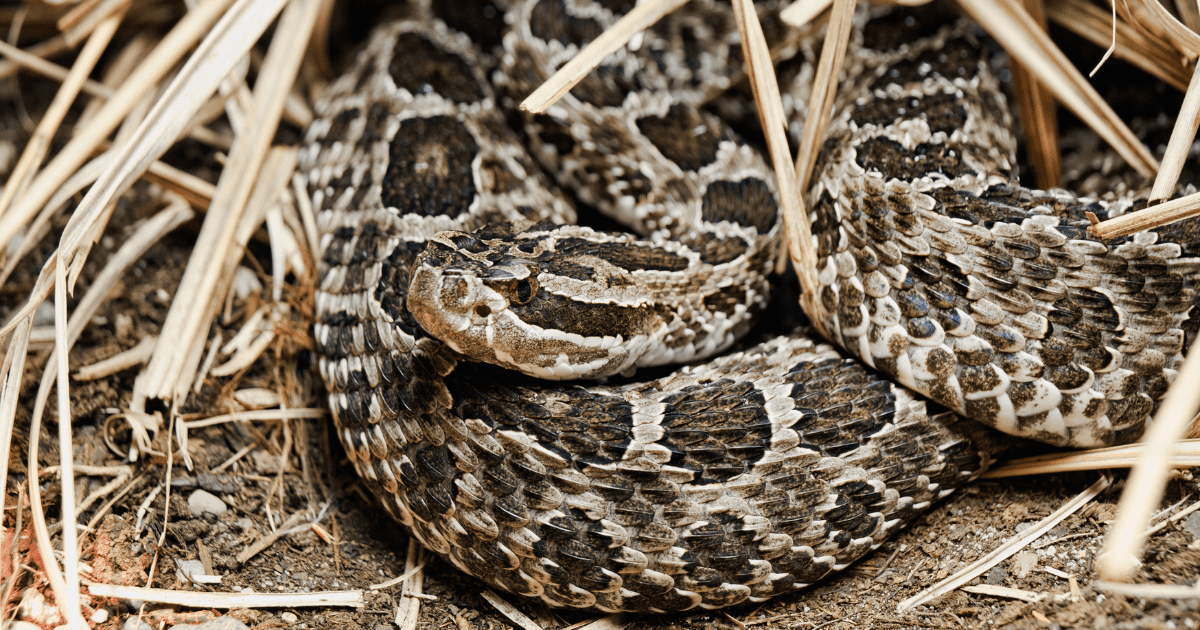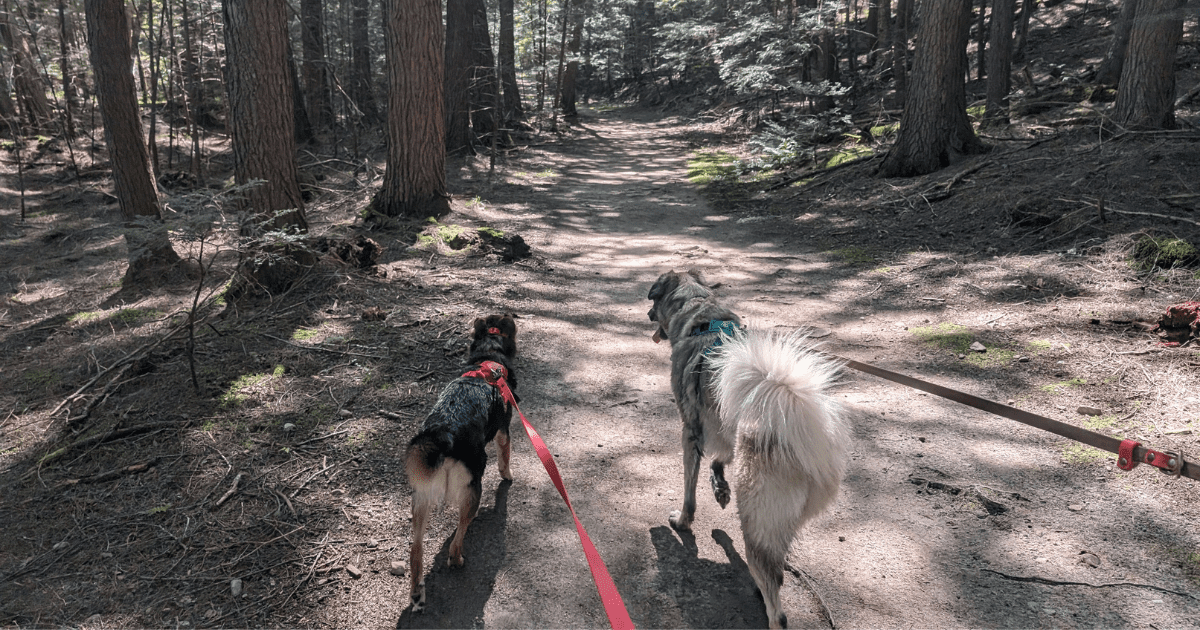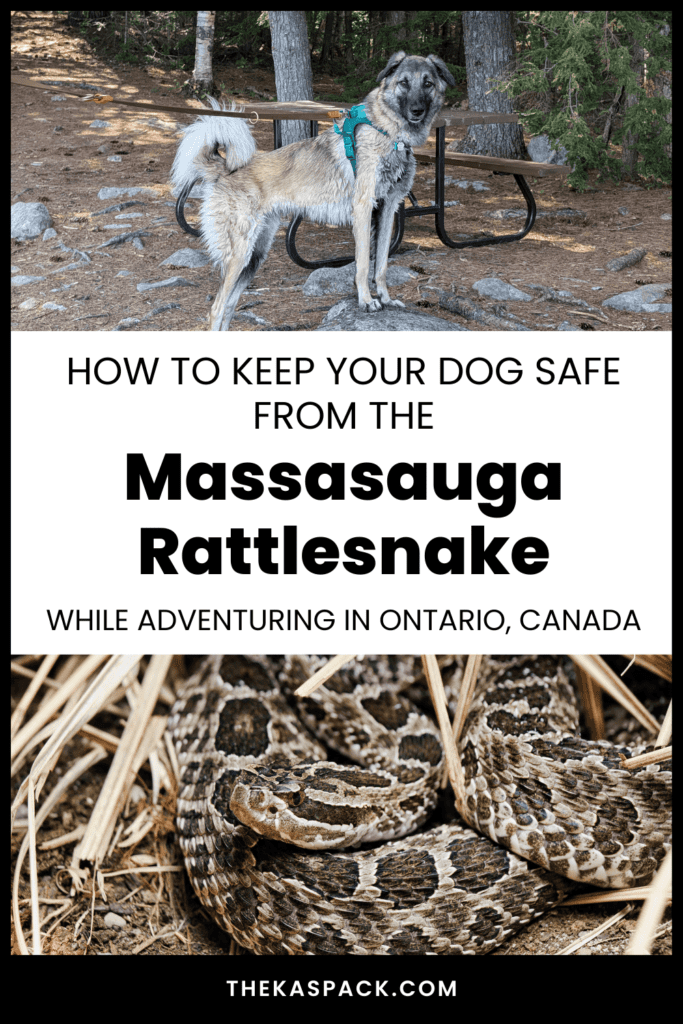Massasauga Rattlesnake Safety and Your Pet
Knowing the potential risks and dangers is an essential part of safe and responsible outdoor adventures.
While most pet-friendly travellers are familiar with the threat of heatstroke during the summer, toxic plants growing across the province, and potential predators like bears and coyotes, one risk is often unknown or overlooked – the Massasauga rattlesnake.
Many outdoor lovers in Ontario are unaware that we have a venomous snake in the province.
In this post, I will share valuable information about identifying Massasauga rattlesnakes, avoiding danger, and responding appropriately in case of a bite.
Learning the basics of rattlesnake safety will allow you and your dog (or cat) to share safe and enjoyable outdoor adventures.

About the Eastern Massasauga Rattlesnake
The Massasauga rattlesnake is Ontario’s only venomous snake.
A full-grown adult measures approximately 2 to 3 feet long, making them relatively small compared to other venomous snakes.
They are brown or grey with darker bands or patches along their body. This allows them to easily blend into the forests, grasslands, and wetlands where they live.
Their diet primarily consists of small rodents (like mice), frogs, and lizards.
Contrary to popular belief, being venomous doesn’t mean they are aggressive or likely to attack anything that comes near. They are actually very timid creatures.
Massasauga rattlesnake bites are rare because they will not strike unless they feel threatened and have no other option.
Labelled a “Threatened” species, they are not endangered, but the population is concerningly low, and they will likely become endangered if steps aren’t taken to protect them.
Where in Ontario Does the Massasauga Rattlesnake Live?
While the Massasauga rattlesnake once lived throughout Southwestern Ontario and along the shores of the Great Lakes, their dwindling population has cut this back significantly.
Today, they can be found mainly in the following locations:
- Bruce Peninsula
- Eastern side of Georgian Bay
- Wainfleet Bog, northeast shore of Lake Erie near Windsor
However, there is always the possibility you may encounter a Massasauga rattlesnake in another location due to unexpected circumstances.
For example, posts in a local Facebook group revealed that one washed up on the shores of Wasaga Beach.
It is believed this particular snake was swept away in the rough water from its usual habitat and carried to that location.
The Wasaga Beach visitor has since been captured and cared for by a qualified rescue.
How to Identify a Massasauga Rattlesnake
If you are camping or hiking in one of the areas identified above, knowing how to identify the Massasauga rattlesnake from other local snakes is key.
Several different snakes are found across Ontario, most of which are completely harmless.
The first sign you may be dealing with a Massasauga rattlesnake is the signature rattle sound from their tail.
However, they aren’t the only snakes that rattle. You may hear a similar sound from the fox snake, milk snake, or water snake.
If you can’t see the snake but hear the rattle, treat the situation like it is a rattlesnake.
If you can see the snake, you can look for the following physical characteristics:
- Darker blotched pattern or darker stripes along the body
- Diamond-shaped head
- Vertical pupils
Anyone who spots a Massasauga rattlesnake is encouraged to report the sighting. This is valuable information for researchers and those working to protect the species.
Try to grab a photo or video if you can do so safely.
You can also submit your sightings on the Ontario Reptile and Amphibian Atlas.

How Dangerous is the Massasauga Rattlesnake to Your and Your Pet?
As previously stated, the Massasauga rattlesnake isn’t an aggressive species. They don’t attack unprovoked.
With careful attention to your surroundings and the safety tips listed below, most outdoor adventurers will go their entire lives without a problem.
But it’s important to remember that they are venomous.
If you or your pet is bitten, you will need medical attention as quickly as possible. Left untreated, a bite can be life-threatening.
With proper care, most people and pets will make a full recovery.
There are only two recorded cases of people dying in Ontario from a Massasauga rattlesnake bite, but it is possible.
The risk is higher for most pets due to the difference in size, especially if your travel buddy is a small/toy breed dog or a cat.
What Should You Do if You or Your Pet is Bitten?
If someone in your group, human or pet, has been bitten, stay calm! The worst thing you can do is panic.
In cases where the snake is visible, try to take note of the appearance or take a photo to help with identification and determining the course of treatment.
Here are the steps to take to get to safety and seek medical attention as quickly as possible:
If You Are Bitten
- Sit down and stay calm. This will help slow your heart rate, slowing the blood flow and the flow of venom through your body.
- Remove any items that may be constricting if you experience swelling around the bite. This includes rings, bracelets, anklets, etc.
- Wash and cleanse the bite area with soap or alcohol wipes.
- Keep the bitten area or limb as still as possible. This may require splinting a limb. Where possible, keep the bite below the level of your heart.
- Call 911 to arrange transportation to the hospital. They will also notify the hospital staff that you will be arriving so they can prepare.
If Your Pet is Bitten
- Try to keep your pet calm and keep them from moving around as much as possible.
- If the bite is on a limb, use a splint to restrict movement.
- Carry your pet; do not allow them to walk. If you have a large dog, an emergency harness like the The Airlift from Fido Pro is a game changer.
- Get your pet to the nearest veterinarian or emergency clinic for treatment.
What NOT to Do if You or Your Pet is Bitten
There is a lot of misinformation out there, thanks to well-intentioned people and inaccurate depictions of snake bites in the media.
Avoid the following incorrect recommendations:
- Do not apply ice to the bite
- Do not cut the bite area to “release the venom”
- Do not use suction to try to remove the venom
- Do not apply a tourniquet to the affected limb
Your best chance of a full recovery will be to get to the hospital/emergency veterinary clinic as quickly as possible for professional care.

Tips for Staying Safe in Rattlesnake Territory
Knowing how to respond to a snake bite is critical information for any pet-friendly outdoor traveller, but the best option is to prevent a bite from happening to begin with.
The following tips and tricks will help you avoid trouble and keep both you and your pet safe:
Make Sure You Know Where to Find Medical Help
Before heading out to hike or camp in a new location, research the available medical care in the area.
This includes both knowing where the hospital is for you and where to find emergency veterinary care for your dog or cat.
I recommend making a list of available options with phone numbers and addresses and adding that list to the hiking first aid kit you will be carrying.
Wear Protective Gear in Known Habitats
If you are heading into an area where the Massasauga rattlesnake is known to reside, dress accordingly.
Wear hiking boots and long pants to cover your legs and ankles.
There are also options for dogs in high-risk areas, protecting their legs, chest, and neck. However, those are usually only used in the south, where there are more dangerous snakes.
While we don’t use dog protective gear, I prioritize covering my legs to protect against ticks and allow me to focus in the moment on keeping my pet safe while knowing I have a level of protection.
Be Aware of Your Surroundings
When hiking, ensure you are aware of and pay attention to your pet and surroundings.
Do you usually hike with your headphones on? Your best option in a known rattlesnake area is to leave the headphones at home so you can hear the warning rattle.
Pay careful attention to any signs of movement on the trail ahead or in the vegetation on each side.
Hike with Proper Lighting at Night
The importance of paying attention to your surroundings doesn’t end when the sun goes down. One could argue it’s more important than ever.
If you’re heading out after dark or there is a risk the sun may go down before you get home, bring the gear needed to light up the trail.
Some hikers are happy using a traditional flashlight, but I prefer a headlamp to keep my hands free.
Stay on the Trail/Designated Campsite
As mentioned, the Massasauga rattlesnake doesn’t want to encounter you or your pet. They will actively try to hide from any perceived threat.
This means you are far more likely to encounter a rattlesnake when walking through tall vegetation than you would by staying on a groomed trail.
When hiking with pets, keep your pet on the trail as well.
It can be tempting to let your dog sniff off in the bush. I get it. But this can put your best friend at much higher risk.
Only Unleash Your Dog in Specific Situations
This is a point that we make regularly here at The Kas Pack, as we are firm believers that responsible pet parents will follow the leash laws/rules at the locations they visit.
Even if you think your dog is well-trained off-leash, these rules are in place for a reason.
If you are in an area that allows dogs off-leash, be very honest with yourself about your dog’s current training and recall skills.
As we just mentioned, keeping your dog on the trail is important in rattlesnake territory. If this means needing a leash to limit where they can go, it’s for their own good.
Train Key Commands like “Leave It”
You can do everything “right” and still end up in a situation where your pet finds or encounters a rattlesnake when outdoors.
Should that happen, does your pet have the basic obedience skills to keep them safe?
“Leave it” is a very valuable command on the trails. It lets you redirect your pet away from something of concern, like garbage, a toxic plant, or, in this case, a snake.
Being able to verbally tell your pet to leave a snake while you move to get them to safety may offer you valuable seconds to physically intervene.
If your pet doesn’t already know this command, this is your sign to incorporate it into your training.

Final Thoughts: Massasauga Rattlesnake Safety
By learning about the Massasauga rattlesnake, including its habitat, how to identify it, and what to do if you spot a snake, you can reduce the risk of trouble while enjoying these beautiful areas of our province.
Remember, these snakes are timid creatures and prefer to avoid humans and their pets.
If you spot a Massasauga rattlesnake on your hike, take pictures or videos, but keep your distance. If you don’t bother them, they won’t bother you.
In the event of a bite, stay calm and get the victim to medical help as quickly as possible.
As outdoor travellers, we are stepping into their territory. Recognizing this and taking precautions will allow us all to coexist safely.
Have you ever seen a Massasauga rattlesnake while exploring Ontario? If so, we’d love to know where!
